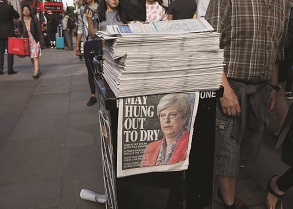News / Strength and stability
While it was clear before June’s general election that the next five years would be pivotal for health and social care, the election result is likely to mean that any changes in the health service in England will be evolutionary rather than revolutionary.
Theresa May’s government may have returned to office, but, with the support from the Democratic Unionist Party, it only has a razor-thin working majority of 13. That’s not a platform from which to launch a major programme of reform. Jeremy Hunt’s reinstatement as health secretary was perhaps a sign that the prime minister wants no major upheaval in health, and that most of the action may take place away from Parliament.

In truth, the Conservatives were not planning a huge reform of the service – much of their attention will focus on mental health and a new patient safety framework. They know that most of Parliament’s time will be taken up in dealing with exiting the European Union – bringing EU law into British law and scrutinising the outcomes of negotiations with Brussels.
However, in its manifesto Mrs May’s party did include a provision to review, and if necessary amend, the NHS internal market. Changes that did not require amended legislation will be brought in for the 2018/19 financial year, it said.
Generally, amendments to the working of the internal market are seen as simply reflecting the direction of travel towards a more collaborative system under the Five-year forward view. While changes are still likely, broader changes that would require legislation, potentially such as amending competition rules or creating statutory accountable care organisations, are less so.
‘Changes in legislation to support delivery of the forward view now seem unlikely, if only because they would act as a lightning rod for opposition parties seeking to attack the government’s stewardship of the NHS,’ says King’s Fund chief executive Chris Ham.
‘In the absence of legislation, NHS England will continue to promote evolutionary changes to the organisation of the NHS, including collaboration and in some cases mergers between clinical commissioning groups.
‘Accountable care systems (ACSs), in which NHS organisations come together to plan and deliver care, will also become more prominent.’
Many commentators see the election result as strengthening the hand of NHS England chief executive Simon Stevens, who has reportedly had a tense relationship with Number 10 during the last year. With Downing Street weakened, he will have a freer rein to implement the forward view, they reason.
Indeed, speaking at the NHS Confederation conference in June, Mr Stevens signalled full steam ahead on the plan, rolling out ACS schemes and announcing a new devolution deal for Surrey Heartlands, similar to that in Greater Manchester.
However, the election demonstrated that delivering the forward view through local sustainability and transformation plans, which are already dogged by controversy, will be anything but plain sailing.
Many plans include the reorganisation of services, moving them out of hospital and into the community. However, to the public, the hard, unqualified facts of ward closures or the consolidation of local A&E or maternity services look like cuts.
Conservative backbenchers, many of whom are now sitting on smaller majorities, will be nervous of changes to hospital services in their constituencies. They will point to Canterbury as a warning, where Labour candidate Rosie Duffield, who opposed changes in local hospital provision, narrowly beat the incumbent Tory MP – the first time in more than 100 years that a Conservative has not taken the constituency.
‘Some STPs include plans to reconfigure acute hospital services—for example, by centralising services to tackle workforce shortages and improve patient outcomes. The new government is likely to be sensitive about these changes in the light of public concerns about the downgrading of local hospitals,’ Professor Ham said.
Nuffield Trust chief executive Nigel Edwards said local changes could be more difficult to achieve. ‘Several MPs have run explicitly against changes in areas such as North Oxfordshire and West Devon, where the winning Conservative candidate has vowed to leave his party if the local A&E is closed.
‘Meanwhile, the Labour Party’s proposals to halt the STPs and oppose hospital closures seemed to resonate with public concerns and may well have been behind some of the high-profile swings to Labour, such as the dramatic result in Canterbury.’
Public engagement is vital, Health Foundation chief executive Jennifer Dixon insisted. ‘Next steps on the NHS five-year forward view outlines five key principles for public engagement and four tests where significant hospital bed closures are on the table. These appropriately require a lot of shoe leather diplomacy – communication, communication, communication – a task which, because of the election results in some areas, just got a whole lot harder,’ she said.
While the task is local, the government could smooth the process by ensuring proposals are robust, consulted on and adjudicated adequately. ‘There is little mention of these issues in the 2017/18 NHS mandate. Without more action, surely the result will be an avoidable and drawn-out challenge, and the government having to back off some needed change,’ she added.
NHS funding will remain under question. In the manifesto, the Conservatives promised a minimum of £8bn for the NHS in real terms over five years. Commentators such as the Nuffield Trust and the Health Foundation said this was insufficient for the service’s needs – a conclusion they reached on all the main parties’ NHS spending pledges.
According to the Nuffield Trust, the pledge would mean an increase of overall health spending in England to £131.7bn by 2022/23. The organisation said the NHS will require between £137bn and £155bn a year by that time.
It remains to be seen if chancellor Philip Hammond will stick to the manifesto plans, especially as Labour’s gains in the polls are being interpreted as a vote against austerity. How will the spending plans square with Jeremy Hunt’s comments at the NHS Confederation conference last month, when he hinted that the 1% cap on pay rises – for nurses in particular – could end?
The Nuffield Trust’s Nigel Edwards said finding additional funding will be difficult. There is little room to cut other services, especially with newly empowered Conservative backbenchers ready to use their influence. And, the agreement with the DUP (see box) means the government cannot implement its planned end to the triple lock on state pensions (which ensures a 2.5% rise each year) or introduce means testing for winter fuel allowances.
‘If running a government with no overall majority were not difficult enough, the prize for being the largest party in this election is being in power at the point that the health and social care system has run out of financial road,’ Mr Edwards said.
He added that the focus on operational performance, such as the key four-hour A&E waiting time target, will be ramped up in response to public concern about the NHS.
There are a further two questions, which will remain outside the control of the NHS – the settlement on EU exit and the long-term funding of social care. While the government has promised a consultation on the latter, the former will dominate this Parliament.
The NHS will want a deal that maintains economic growth (underpinning rising spending) and clarifies the future of EU citizens working in the health service. In June, as negotiations began, the prime minister outlined plans to give reciprocal settled status to EU nationals who have lived in the UK for at least five years. While not referencing EU workers in the NHS specifically, she added that EU citizens who have lived in the UK for less than five years will be able to stay and apply for settled status once the five-year threshold has passed.
Broadly, the election has changed little for the NHS in England – there will still be austerity, high levels of cost savings will be required and there will be pressure on operational performance targets. And the service will embark on STP engagement with a sceptical public with, potentially, less political support than they might have hoped for before the general election.
Northern Ireland boost
The minority government could be a positive outcome for public services in Northern Ireland. As well as agreements on national policies, such as those on pensions, the deal struck between the government and the DUP at the end of June handed an extra £1bn over two years to the overall Northern Ireland budget.
This will include a minimum of £250m – which is likely to be topped up to around £300m – for health and social care, which previously had a budget of around £5bn.
Much of the new money will be spent on reducing waiting lists and transforming care, although £50m has been allocated for mental health service improvements.

Northern Ireland has some of the longest waiting times – in 2016/17 just over 74% of A&E patients were treated, discharged or admitted within four hours, while in December 2016 almost a quarter of a million patients were waiting for a first outpatient appointment – 47,000 of them for more than a year.
However, with the local parties at an impasse over forming a new Assembly executive – though talks continued as Healthcare Finance went to press – health and social care and other public spending programmes do not have a confirmed budget for 2017/18.
Related content
The Institute’s annual costing conference provides the NHS with the latest developments and guidance in NHS costing.
The value masterclass shares examples of organisations and systems that have pursued a value-driven approach and the results they have achieved.